rear view mirror TOYOTA RAV4 PLUG-IN HYBRID 2021 Owner's Manual
[x] Cancel search | Manufacturer: TOYOTA, Model Year: 2021, Model line: RAV4 PLUG-IN HYBRID, Model: TOYOTA RAV4 PLUG-IN HYBRID 2021Pages: 666, PDF Size: 161.28 MB
Page 292 of 666
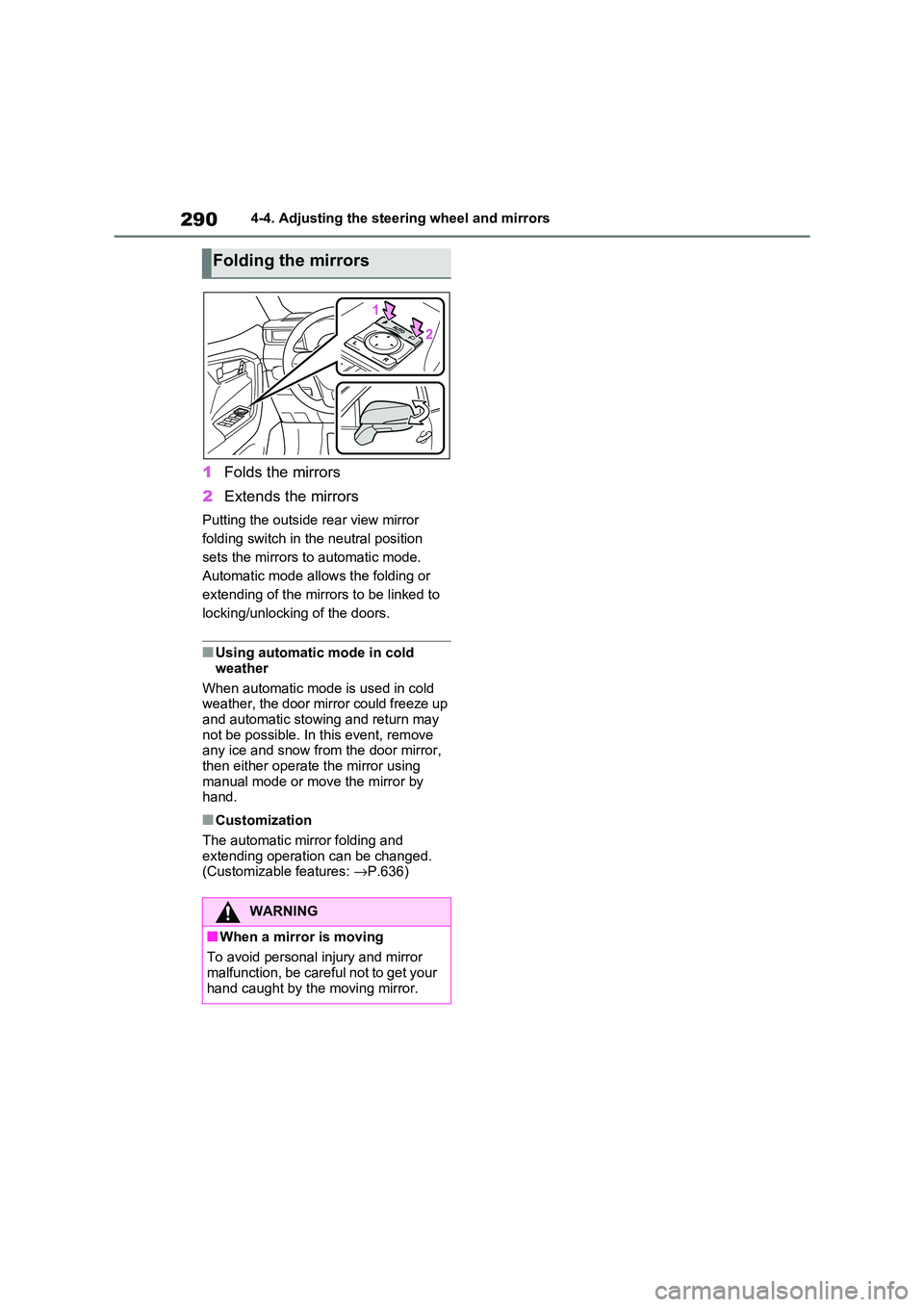
2904-4. Adjusting the steering wheel and mirrors
1Folds the mirrors
2 Extends the mirrors
Putting the outside rear view mirror
folding switch in the neutral position
sets the mirrors t o automatic mode.
Automatic mode allows the folding or
extending of the mirrors to be linked to
locking/unlocking of the doors.
■Using automatic mode in cold
weather
When automatic mod e is used in cold
weather, the door mirror could freeze up
and automatic stowing and return may not be possible. In this event, remove
any ice and snow fro m the door mirror,
then either operate the mirror using manual mode or mov e the mirror by
hand.
■Customization
The automatic mirror folding and extending operati on can be changed.
(Customizable features: →P.636)
Folding the mirrors
WARNING
■When a mirror is moving
To avoid personal injury and mirror malfunction, be careful not to get your
hand caught by the moving mirror.
Page 304 of 666
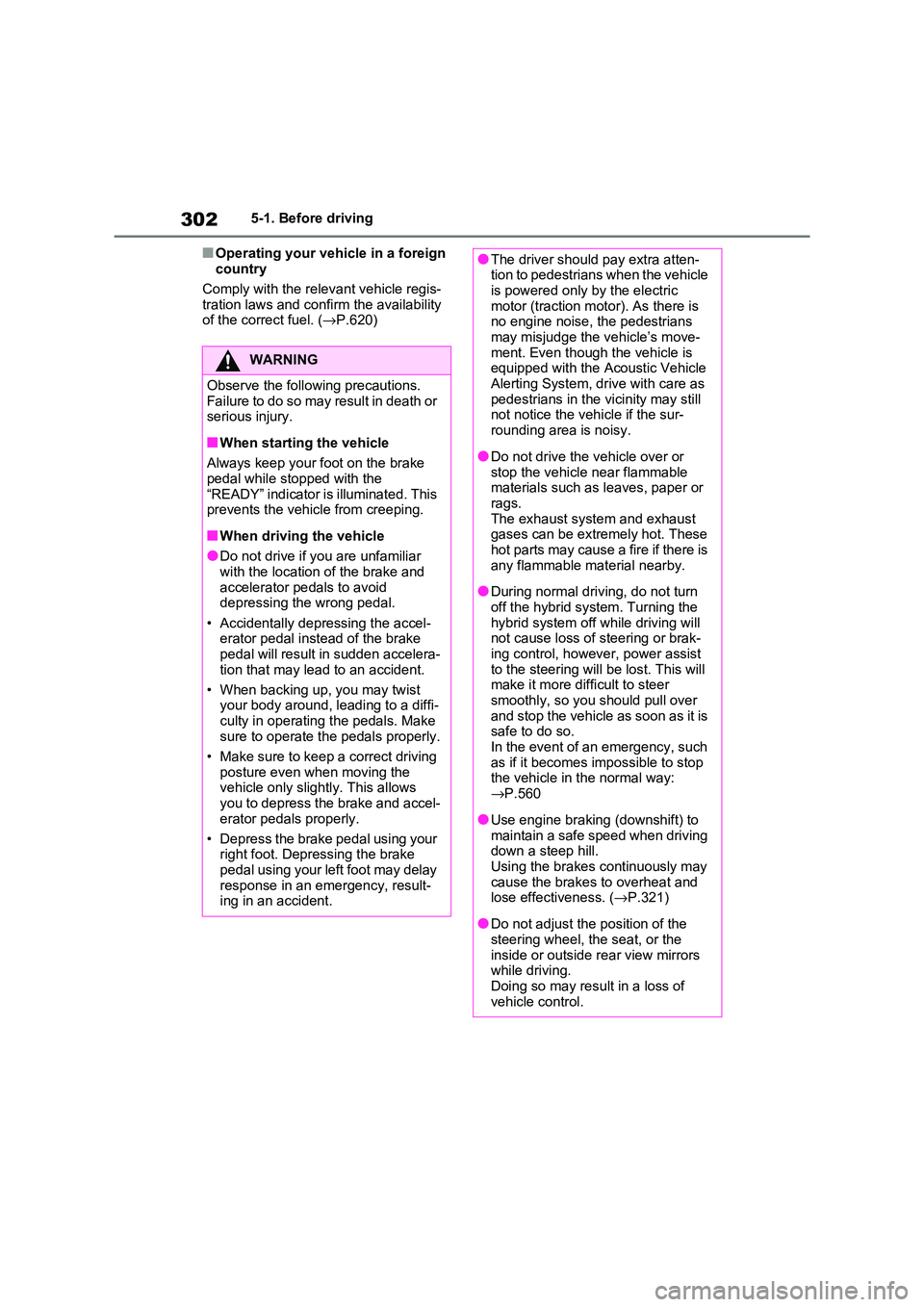
3025-1. Before driving
■Operating your vehicle in a foreign
country
Comply with the rele vant vehicle regis-
tration laws and confi rm the availability
of the correct fuel. ( →P.620)
WARNING
Observe the following precautions.
Failure to do so may result in death or
serious injury.
■When starting the vehicle
Always keep your f oot on the brake
pedal while stopped with the “READY” indicator is illuminated. This
prevents the vehicle from creeping.
■When driving the vehicle
●Do not drive if you are unfamiliar
with the location of the brake and accelerator pe dals to avoid
depressing the wrong pedal.
• Accidentally depressing the accel - erator pedal instead of the brake
pedal will result in sudden accelera -
tion that may lead to an accident.
• When backing up, you may twist
your body around, leading to a diffi -
culty in operating the pedals. Make sure to operate th e pedals properly.
• Make sure to keep a correct driving
posture even when moving the vehicle only slightly. This allows
you to depress the brake and accel -
erator pedals properly.
• Depress the brake pedal using your
right foot. Depressing the brake
pedal using your left foot may delay response in an emergency, result -
ing in an accident.
●The driver should pay extra atten - tion to pedestrians when the vehicle
is powered only b y the electric
motor (traction motor). As there is no engine noise, the pedestrians
may misjudge the vehicle’s move-
ment. Even though the vehicle is equipped with the Acoustic Vehicle
Alerting System, drive with care as
pedestrians in the vicinity may still not notice the ve hicle if the sur-
rounding area is noisy.
●Do not drive the vehicle over or
stop the vehicle near flammable
materials such as leaves, paper or rags.
The exhaust system and exhaust
gases can be extremely hot. These hot parts may cause a fire if there is
any flammable material nearby.
●During normal driving, do not turn
off the hybrid system. Turning the
hybrid system off while driving will not cause loss of steering or brak -
ing control, however, power assist
to the steering will be lost. This will make it more difficult to steer
smoothly, so you should pull over
and stop the vehicle as soon as it is safe to do so.
In the event of an emergency, such
as if it becomes impossible to stop the vehicle in the normal way:
→ P.560
●Use engine braking (downshift) to
maintain a safe speed when driving
down a steep hill. Using the brakes continuously may
cause the brakes to overheat and
lose effectiveness. ( →P.321)
●Do not adjust the position of the
steering wheel, t he seat, or the
inside or outside rear view mirrors while driving.
Doing so may result in a loss of
vehicle control.
Page 310 of 666
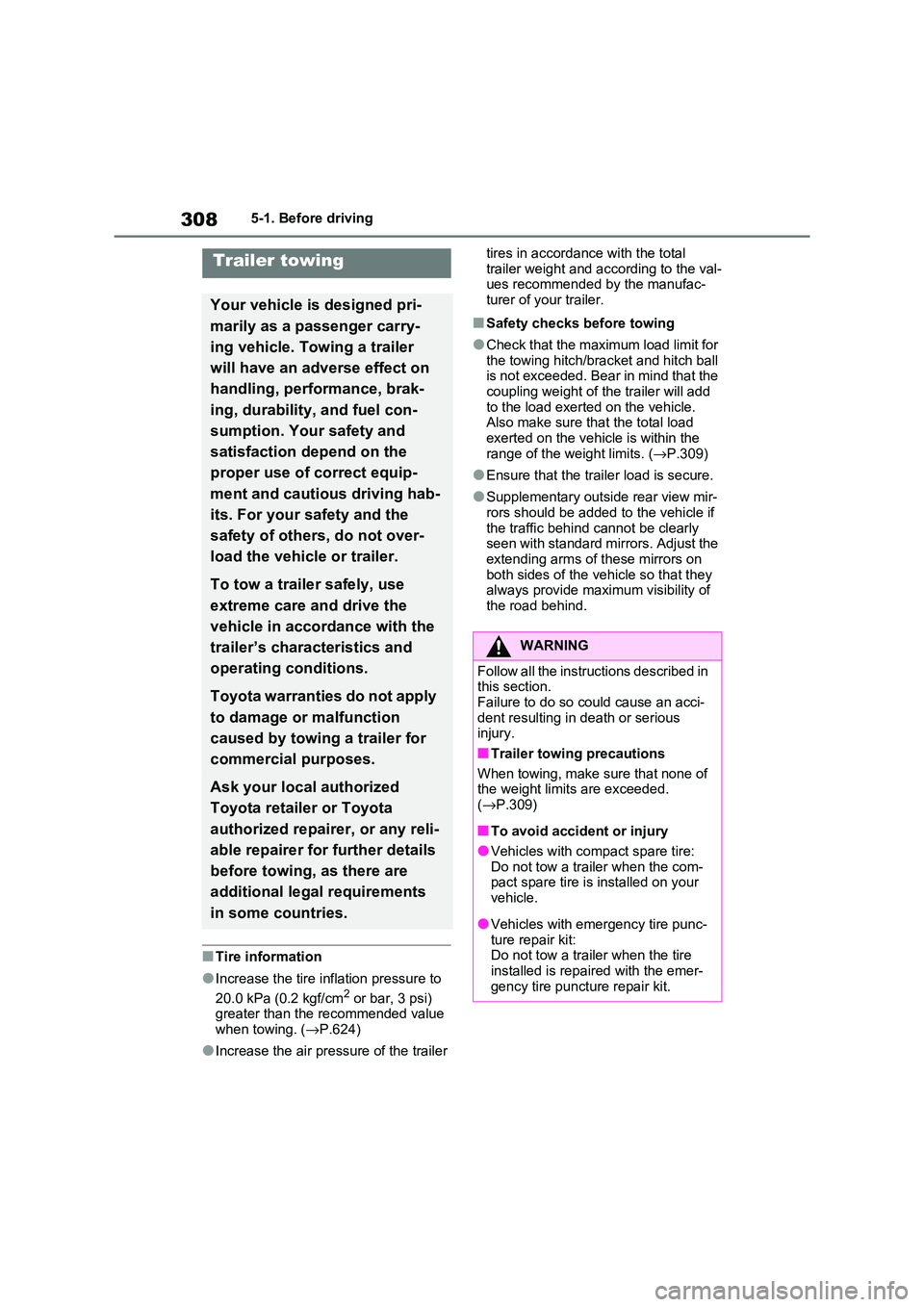
3085-1. Before driving
■Tire information
●Increase the tire inflation pressure to
20.0 kPa (0.2 kgf/cm2 or bar, 3 psi) greater than the recommended value
when towing. ( →P.624)
●Increase the air pressure of the trailer
tires in accordance with the total
trailer weight and according to the val - ues recommended by the manufac -
turer of your trailer.
■Safety checks before towing
●Check that the maximum load limit for
the towing hitch/bracket and hitch ball
is not exceeded. Bear in mind that the coupling weight of the trailer will add
to the load exerted on the vehicle.
Also make sure tha t the total load exerted on the vehi cle is within the
range of the weight limits. ( →P.309)
●Ensure that the trailer load is secure.
●Supplementary outside rear view mir- rors should be added to the vehicle if
the traffic behind c annot be clearly
seen with standard mirrors. Adjust the extending arms of these mirrors on
both sides of the vehicle so that they
always provide maxi mum visibility of the road behind.
Trailer towing
Your vehicle is designed pri -
marily as a passenger carry -
ing vehicle. Towing a trailer
will have an adverse effect on
handling, performance, brak -
ing, durability, and fuel con -
sumption. Your safety and
satisfaction depend on the
proper use of correct equip -
ment and cautious driving hab -
its. For your safety and the
safety of others, do not over -
load the vehicle or trailer.
To tow a trailer safely, use
extreme care and drive the
vehicle in accordance with the
trailer’s characteristics and
operating conditions.
Toyota warranties do not apply
to damage or malfunction
caused by towing a trailer for
commercial purposes.
Ask your local authorized
Toyota retailer or Toyota
authorized repairer, or any reli -
able repairer for further details
before towing, as there are
additional legal requirements
in some countries.
WARNING
Follow all the instructions described in
this section.
Failure to do so could cause an acci - dent resulting in death or serious
injury.
■Trailer towing precautions
When towing, make sure that none of
the weight limits are exceeded.
( →P.309)
■To avoid accident or injury
●Vehicles with compact spare tire: Do not tow a trailer when the com -
pact spare tire is installed on your
vehicle.
●Vehicles with emergency tire punc -
ture repair kit: Do not tow a traile r when the tire
installed is repa ired with the emer-
gency tire puncture repair kit.
Page 348 of 666
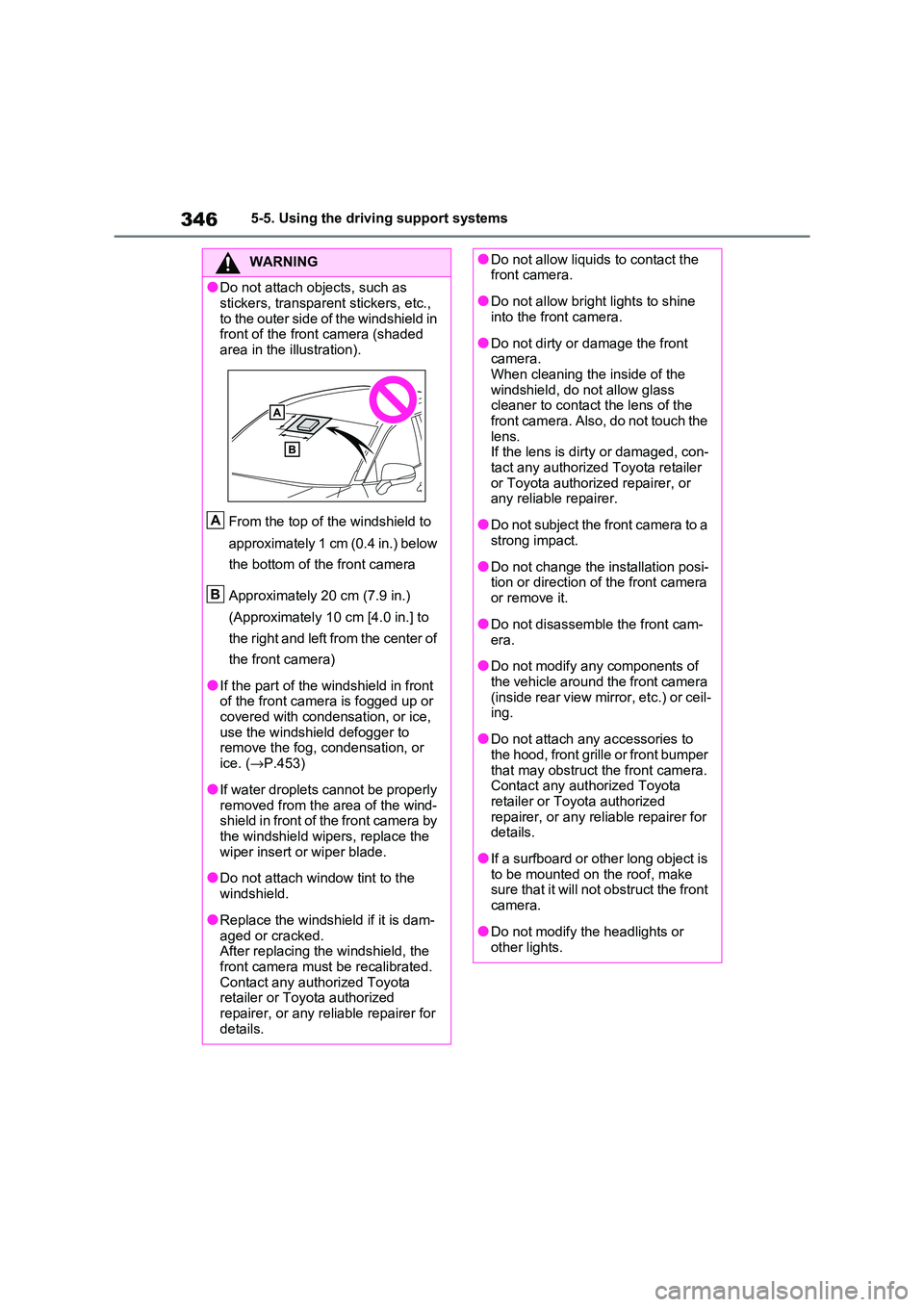
3465-5. Using the driving support systems
WARNING
●Do not attach objects, such as
stickers, transparent stickers, etc.,
to the outer side of the windshield in front of the fron t camera (shaded
area in the illustration).
From the top of the windshield to
approximately 1 cm (0.4 in.) below
the bottom of the front camera
Approximately 20 cm (7.9 in.)
(Approximately 10 cm [4.0 in.] to
the right and left from the center of
the front camera)
●If the part of the wi ndshield in front of the front camera is fogged up or
covered with condens ation, or ice,
use the windshield defogger to remove the fog, condensation, or
ice. ( →P.453)
●If water droplets cannot be properly
removed from the area of the wind-
shield in front of the front camera by the windshield wipers, replace the
wiper insert or wiper blade.
●Do not attach window tint to the
windshield.
●Replace the windshield if it is dam -
aged or cracked.
After replacing the windshield, the
front camera must be recalibrated. Contact any authorized Toyota
retailer or Toyota authorized
repairer, or any reliable repairer for details.
A
B
●Do not allow liquids to contact the front camera.
●Do not allow brigh t lights to shine into the front camera.
●Do not dirty or damage the front camera.
When cleaning the inside of the
windshield, do not allow glass cleaner to contact the lens of the
front camera. Also, do not touch the
lens. If the lens is dirt y or damaged, con-
tact any authorized Toyota retailer
or Toyota authorized repairer, or any reliable repairer.
●Do not subject the front camera to a strong impact.
●Do not change the installation posi - tion or direction of the front camera
or remove it.
●Do not disassemb le the front cam-
era.
●Do not modify any components of
the vehicle around the front camera
(inside rear view mirror, etc.) or ceil - ing.
●Do not attach any accessories to the hood, front grille or front bumper
that may obstruct the front camera.
Contact any authorized Toyota retailer or Toyota authorized
repairer, or any reliable repairer for
details.
●If a surfboard or other long object is
to be mounted on the roof, make sure that it will not obstruct the front
camera.
●Do not modify the headlights or other lights.
Page 395 of 666
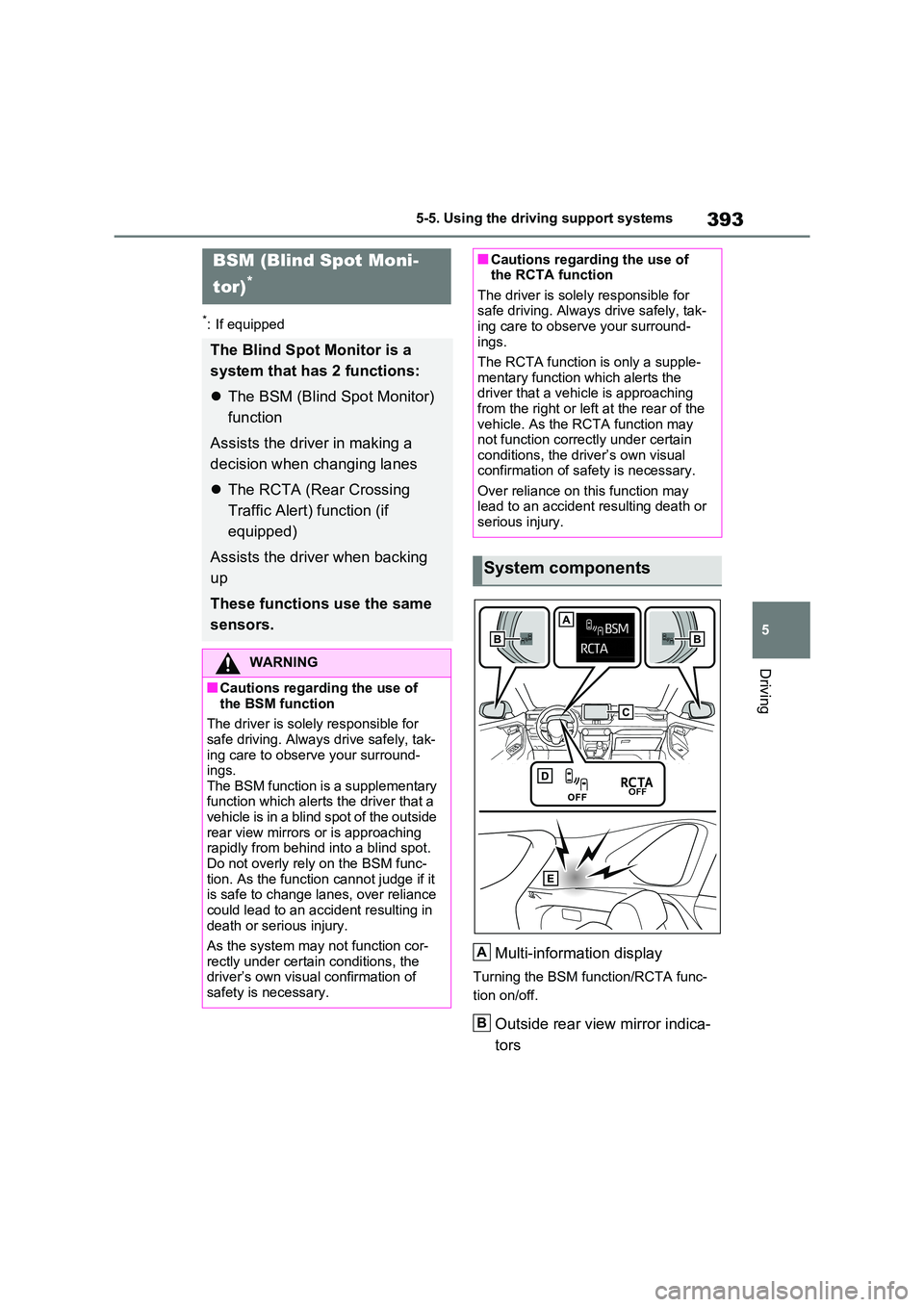
393
5
5-5. Using the driving support systems
Driving
*: If equipped
Multi-information display
Turning the BSM function/RCTA func -
tion on/off.
Outside rear view mirror indica -
tors
BSM (Blind Spot Moni-
tor)*
The Blind Spot Monitor is a
system that has 2 functions:
The BSM (Blind Spot Monitor)
function
Assists the driver in making a
decision when changing lanes
The RCTA (Rear Crossing
Traffic Alert) function (if
equipped)
Assists the driver when backing
up
These functions use the same
sensors.
WARNING
■Cautions regarding the use of the BSM function
The driver is solely responsible for
safe driving. Alwa ys drive safely, tak- ing care to observe your surround -
ings.
The BSM function is a supplementary function which alerts the driver that a
vehicle is in a blind spot of the outside
rear view mirrors or is approaching rapidly from behind into a blind spot.
Do not overly rely on the BSM func -
tion. As the function cannot judge if it is safe to change lanes, over reliance
could lead to an accident resulting in
death or serious injury.
As the system may not function cor -
rectly under certain conditions, the
driver’s own visual confirmation of safety is necessary.
■Cautions regarding the use of the RCTA function
The driver is solely responsible for
safe driving. Always drive safely, tak- ing care to observe your surround -
ings.
The RCTA function is only a supple - mentary function which alerts the
driver that a vehi cle is approaching
from the right or left at the rear of the vehicle. As the RCTA function may
not function correctly under certain
conditions, the driver’s own visual confirmation of saf ety is necessary.
Over reliance on this function may
lead to an accident resulting death or serious injury.
System components
A
B
Page 396 of 666
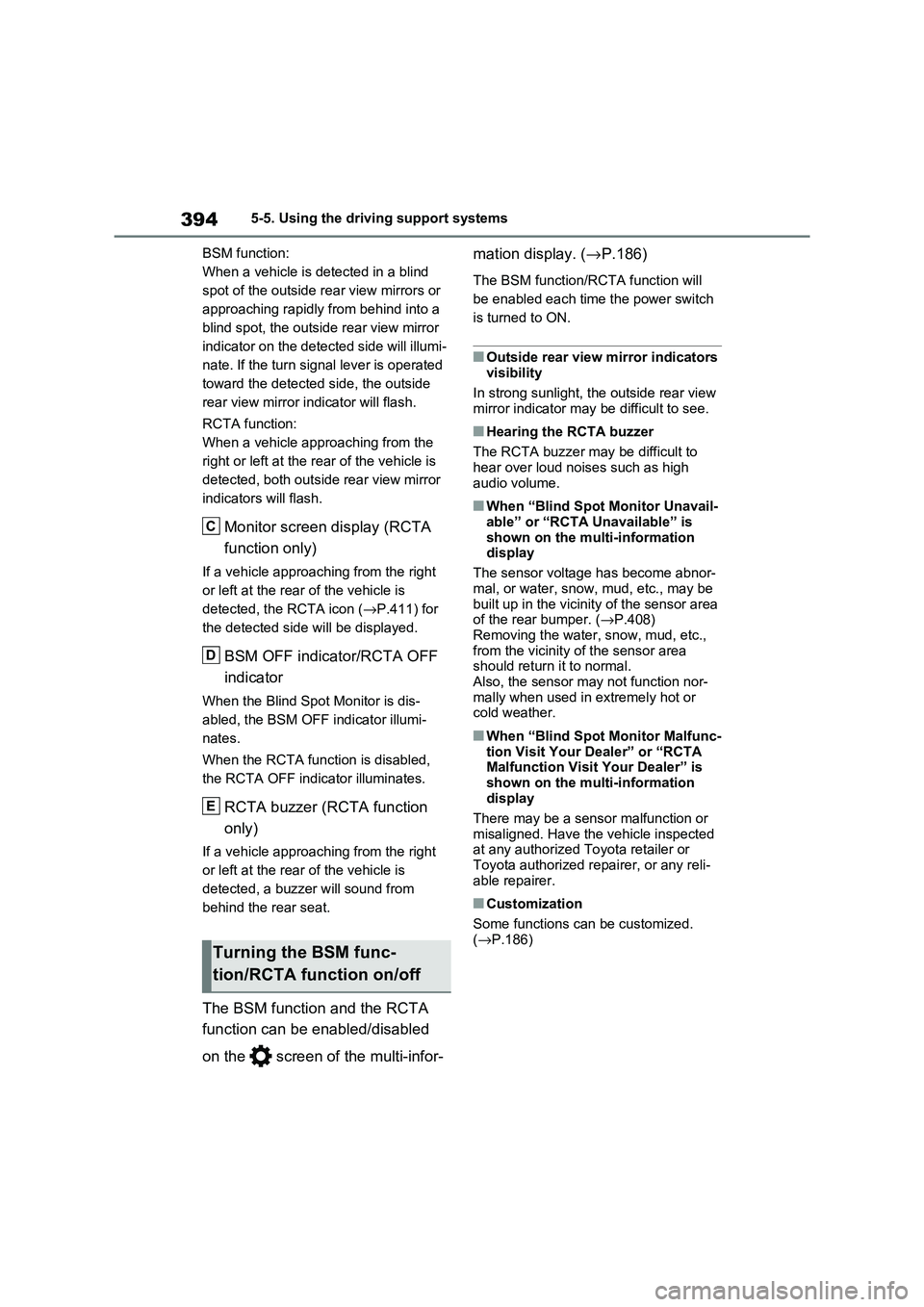
3945-5. Using the driving support systems
BSM function:
When a vehicle is detected in a blind
spot of the outside rear view mirrors or
approaching rapidly from behind into a
blind spot, the outside rear view mirror
indicator on the detected side will illumi -
nate. If the turn signal lever is operated
toward the detected side, the outside
rear view mirror indicator will flash.
RCTA function:
When a vehicle approaching from the
right or left at the re ar of the vehicle is
detected, both outsi de rear view mirror
indicators will flash.
Monitor screen display (RCTA
function only)
If a vehicle approaching from the right
or left at the rear of the vehicle is
detected, the RCTA icon ( →P.411) for
the detected side will be displayed.
BSM OFF indicator/RCTA OFF
indicator
When the Blind Spot Monitor is dis -
abled, the BSM OFF indicator illumi -
nates.
When the RCTA func tion is disabled,
the RCTA OFF indicator illuminates.
RCTA buzzer (RCTA function
only)
If a vehicle approaching from the right
or left at the rear of the vehicle is
detected, a buzzer will sound from
behind the rear seat.
The BSM function and the RCTA
function can be e nabled/disabled
on the screen of the multi-infor -
mation display. ( →P.186)
The BSM function/RCTA function will
be enabled each time the power switch
is turned to ON.
■Outside rear view mirror indicators visibility
In strong sunlight, the outside rear view
mirror indicator may be difficult to see.
■Hearing the RCTA buzzer
The RCTA buzzer may be difficult to
hear over loud noi ses such as high
audio volume.
■When “Blind Spot Monitor Unavail - able” or “RCTA Unavailable” is
shown on the multi-information
display
The sensor voltage has become abnor -
mal, or water, snow, mud, etc., may be
built up in the vicinit y of the sensor area of the rear bumper. ( →P.408)
Removing the water, snow, mud, etc.,
from the vicinity of the sensor area should return it to normal.
Also, the sensor ma y not function nor-
mally when used in extremely hot or cold weather.
■When “Blind Spot Monitor Malfunc -
tion Visit Your Dealer” or “RCTA
Malfunction Visit Your Dealer” is
shown on the multi-information display
There may be a sensor malfunction or
misaligned. Have the vehicle inspected at any authorized To yota retailer or
Toyota authorized repairer, or any reli -
able repairer.
■Customization
Some functions can be customized.
( →P.186)Turning the BSM func-
tion/RCTA function on/off
C
D
E
Page 411 of 666
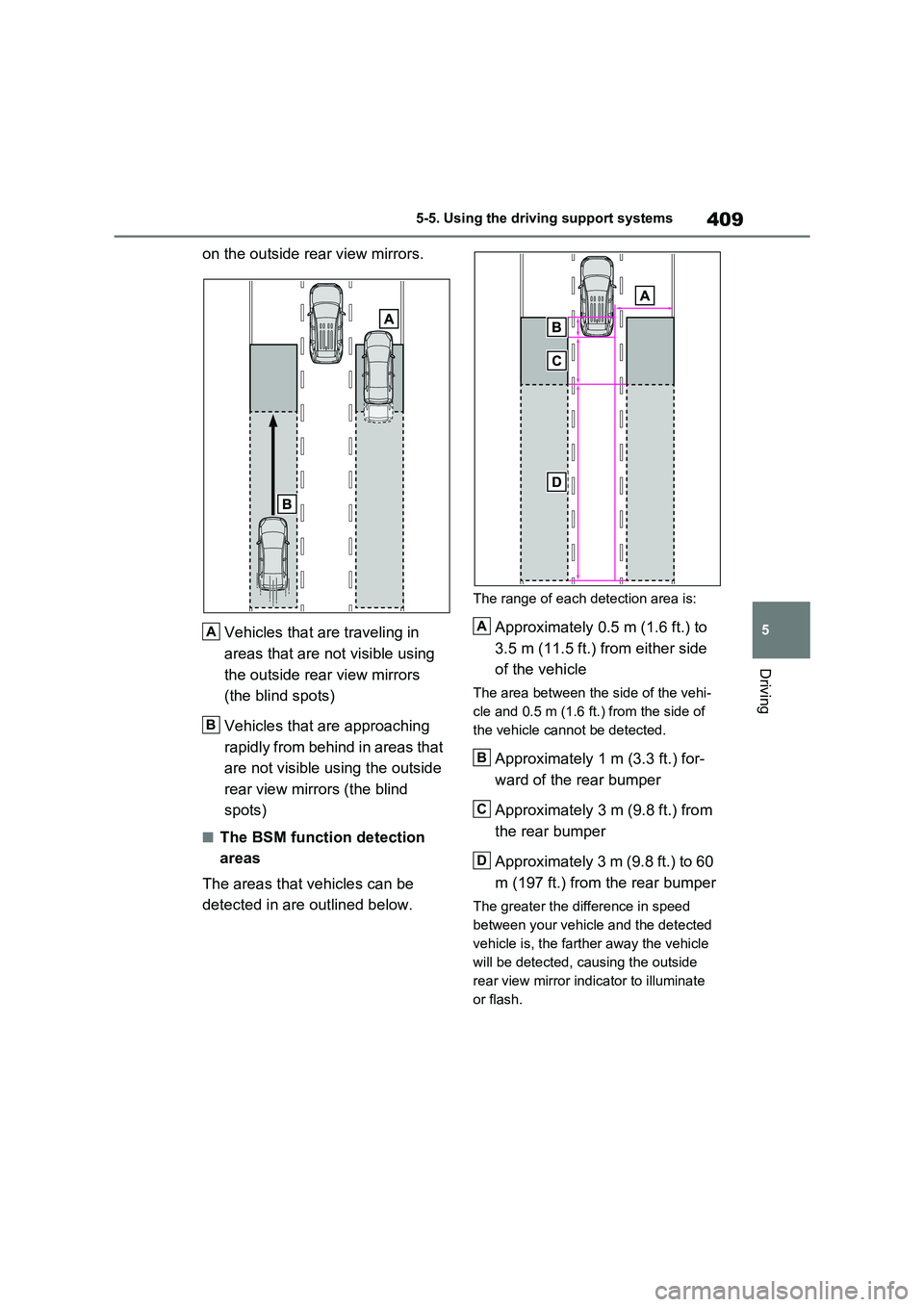
409
5
5-5. Using the driving support systems
Driving
on the outside rear view mirrors.
Vehicles that are traveling in
areas that are not visible using
the outside rear view mirrors
(the blind spots)
Vehicles that are approaching
rapidly from behind in areas that
are not visible using the outside
rear view mirrors (the blind
spots)
■The BSM function detection
areas
The areas that vehicles can be
detected in are outlined below.
The range of each detection area is:
Approximately 0.5 m (1.6 ft.) to
3.5 m (11.5 ft.) from either side
of the vehicle
The area between t he side of the vehi-
cle and 0.5 m (1.6 f t.) from the side of
the vehicle cann ot be detected.
Approximately 1 m (3.3 ft.) for-
ward of the rear bumper
Approximately 3 m (9.8 ft.) from
the rear bumper
Approximately 3 m (9.8 ft.) to 60
m (197 ft.) from the rear bumper
The greater the difference in speed
between your vehicle and the detected
vehicle is, the fart her away the vehicle
will be detected, causing the outside
rear view mirror indi cator to illuminate
or flash.
A
B
A
B
C
D
Page 413 of 666
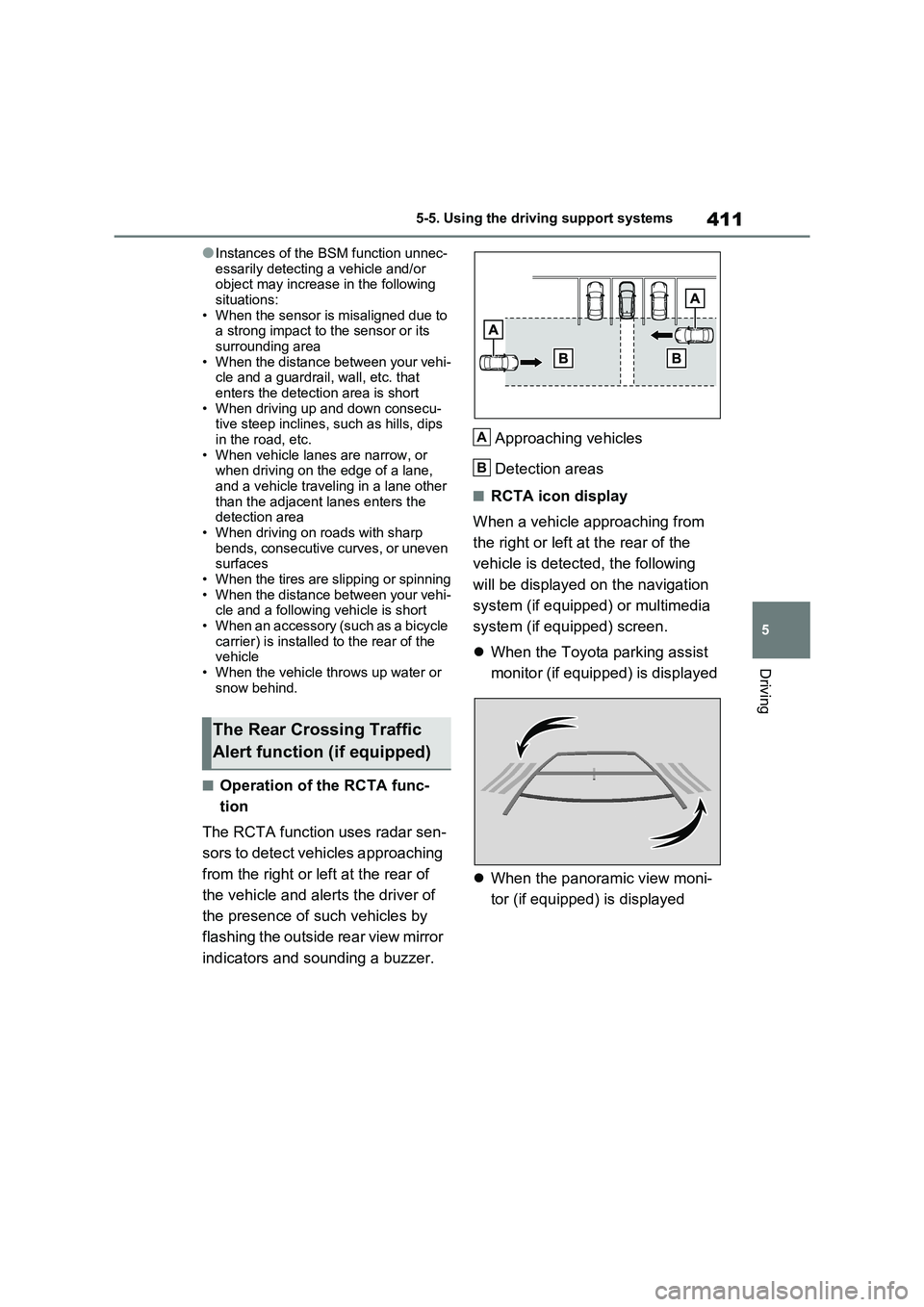
411
5
5-5. Using the driving support systems
Driving
●Instances of the BSM function unnec -
essarily detecting a vehicle and/or object may increase in the following
situations:
• When the sensor is misaligned due to a strong impact to the sensor or its
surrounding area
• When the distance between your vehi - cle and a guardrail, wall, etc. that
enters the detect ion area is short
• When driving up and down consecu - tive steep inclines, such as hills, dips
in the road, etc.
• When vehicle lanes are narrow, or when driving on the edge of a lane,
and a vehicle travel ing in a lane other
than the adjacent lanes enters the detection area
• When driving on roads with sharp
bends, consecutive curves, or uneven surfaces
• When the tires are slipping or spinning
• When the distance between your vehi - cle and a following vehicle is short
• When an accessory (such as a bicycle
carrier) is installed to the rear of the vehicle
• When the vehicle th rows up water or
snow behind.
■Operation of the RCTA func -
tion
The RCTA function uses radar sen -
sors to detect vehicles approaching
from the right or left at the rear of
the vehicle and aler ts the driver of
the presence of s uch vehicles by
flashing the outside rear view mirror
indicators and sounding a buzzer.
Approaching vehicles
Detection areas
■RCTA icon display
When a vehicle approaching from
the right or left at the rear of the
vehicle is detected, the following
will be displayed on the navigation
system (if equipped) or multimedia
system (if equipped) screen.
When the Toyota parking assist
monitor (if equipped) is displayed
When the panoramic view moni-
tor (if equipped) is displayed
The Rear Crossing Traffic
Alert function (if equipped)
A
B
Page 454 of 666
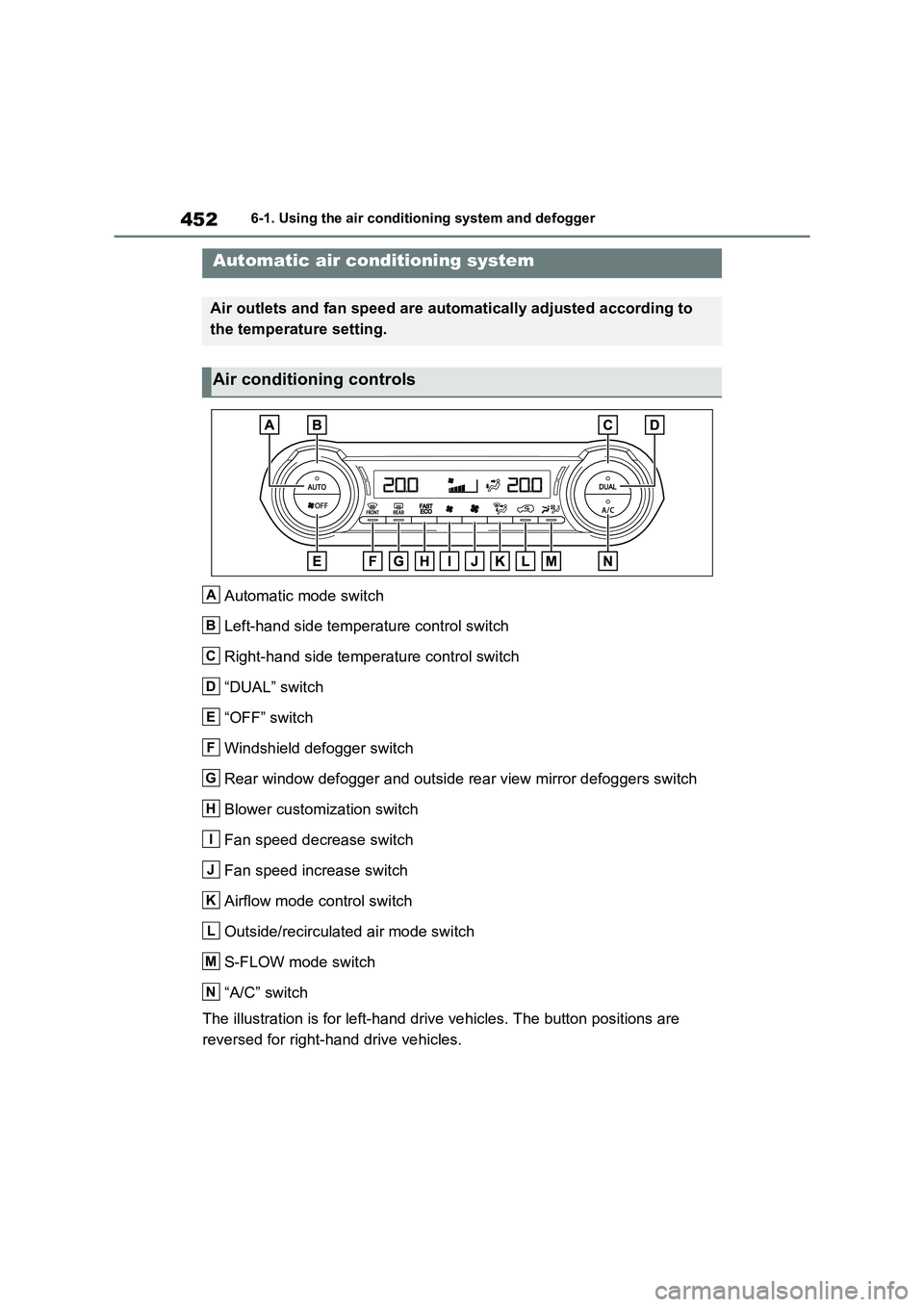
4526-1. Using the air conditioning system and defogger
6-1.Using the air conditioning system and defogger
Automatic mode switch
Left-hand side temperature control switch
Right-hand side temperature control switch
“DUAL” switch
“OFF” switch
Windshield defogger switch
Rear window defogger and outside rear view mirror defoggers swi tch
Blower customization switch
Fan speed decrease switch
Fan speed increase switch
Airflow mode control switch
Outside/recirculated air mode switch
S-FLOW mode switch
“A/C” switch
The illustration is for left-hand drive vehicles. The button positions are
reversed for right-hand drive vehicles.
Automatic air conditioning system
Air outlets and fan speed are au tomatically adjusted according to
the temperature setting.
Air conditioning controls
A
B
C
D
E
F
G
H
I
J
K
L
M
N
Page 456 of 666
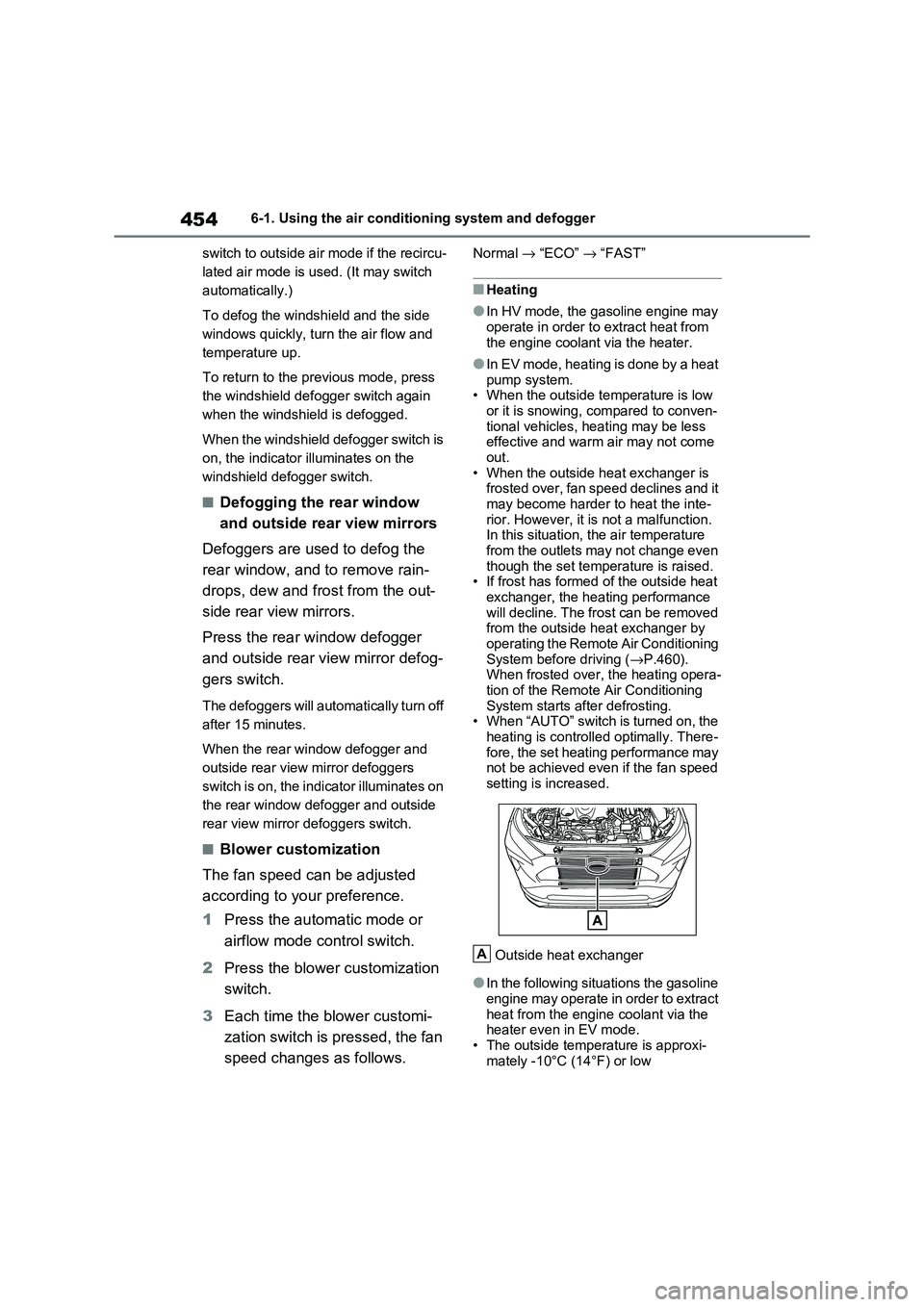
4546-1. Using the air conditioning system and defogger
switch to outside air mode if the recircu -
lated air mode is us ed. (It may switch
automatically.)
To defog the winds hield and the side
windows quickly, turn the air flow and
temperature up.
To return to the p revious mode, press
the windshield defogger switch again
when the windshi eld is defogged.
When the windshield defogger switch is
on, the indicator illuminates on the
windshield defogger switch.
■Defogging the rear window
and outside rear view mirrors
Defoggers are us ed to defog the
rear window, and to remove rain -
drops, dew and frost from the out -
side rear view mirrors.
Press the rear window defogger
and outside rear view mirror defog -
gers switch.
The defoggers will automatically turn off
after 15 minutes.
When the rear window defogger and
outside rear view mirror defoggers
switch is on, the indicator illuminates on
the rear window defogger and outside
rear view mirror defoggers switch.
■Blower customization
The fan speed can be adjusted
according to your preference.
1 Press the automatic mode or
airflow mode control switch.
2 Press the blower customization
switch.
3 Each time the blower customi-
zation switch is pressed, the fan
speed changes as follows.
Normal → “ECO” → “FAST”
■Heating
●In HV mode, the gasoline engine may
operate in order to extract heat from the engine coolant via the heater.
●In EV mode, heating is done by a heat pump system.
• When the outside t emperature is low
or it is snowing, compared to conven - tional vehicles, heating may be less
effective and warm air may not come
out. • When the outside heat exchanger is
frosted over, fan speed declines and it
may become harder to heat the inte- rior. However, it is not a malfunction.
In this situat ion, the air temperature
from the outlets may not change even though the set tem perature is raised.
• If frost has formed of the outside heat
exchanger, the heating performance will decline. The frost can be removed
from the outside heat exchanger by
operating the Remote Air Conditioning System before driving ( →P.460).
When frosted over, the heating opera -
tion of the Remote Air Conditioning System starts after defrosting.
• When “AUTO” switch is turned on, the
heating is controlle d optimally. There- fore, the set heating performance may
not be achieved even if the fan speed
setting is increased.
Outside heat exchanger
●In the following situations the gasoline
engine may operate in order to extract heat from the engine coolant via the
heater even in EV mode.
• The outside temperature is approxi -
mately -10°C (14°F) or low
A